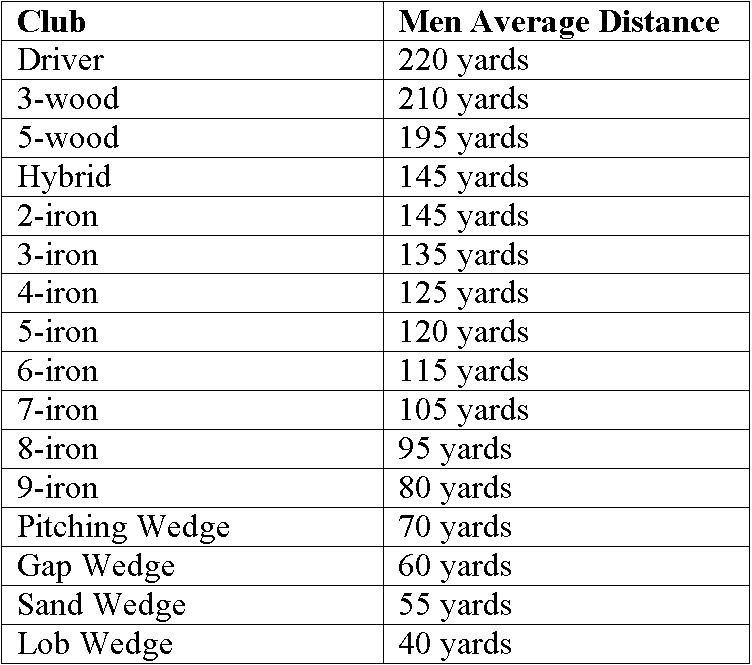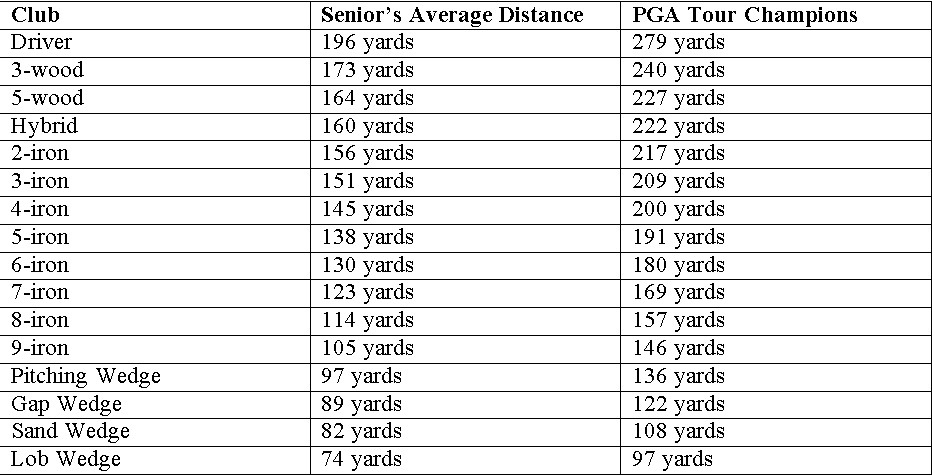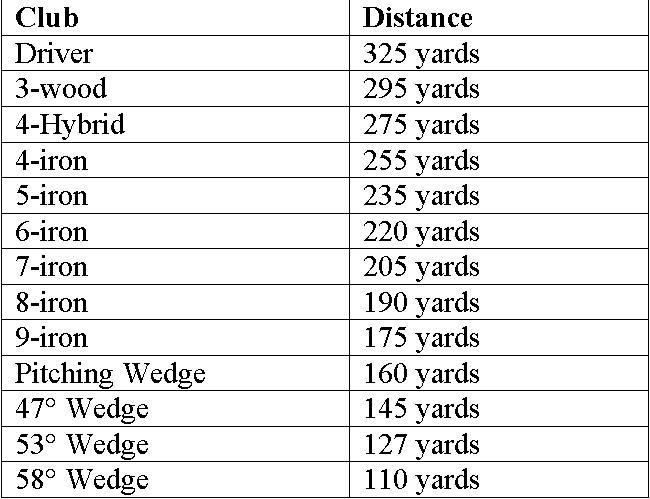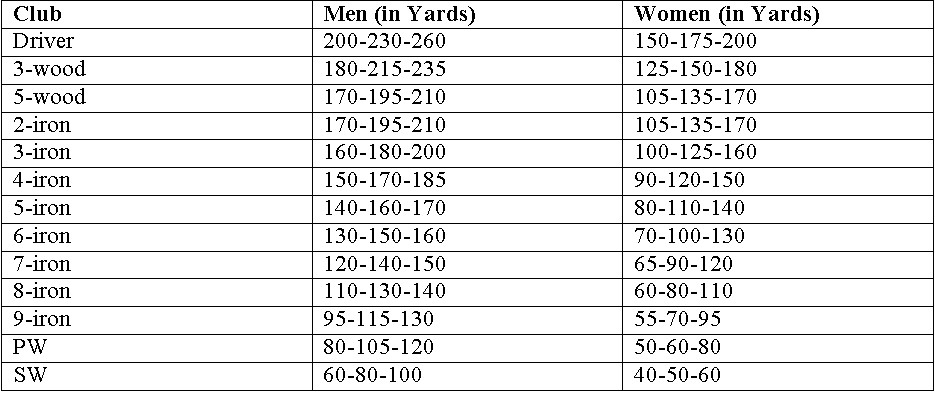This is your place to find out the best way to hit the best courses – is that enough for me? So here we go. Obviously there is no doubt that many golf clubs have long distances that aren’t offensive to readers. The kids will tell you that you have nothing to lose when hitting a ball. The truth is, the score makes sense. I apologize. It is not necessary that the whole thing be hit. In some cases, you might hit certain clubs at a high rate. We start with a club where distance matters.
As an average golfer wanting to get better, it’s only logical to find out all the golf club distances possible. How far you’re hitting as opposed to how far you should be hitting. This kind of information at your disposal is very useful, whether you’re a beginner or not.
But not many players understand that these golf club distances achieved depend on various other factors too, apart from the golf clubs of course. Such as your golf balls, weather conditions, golf swing speed, age, etc.
Whatever the case though, let’s find the average yardages played by men and women using different golf clubs.
Moreover, we tackle the club distance charts for the yardages most golf clubs provide later in the article. The Tables we will provide best describe beginner, amateur, average, and seasoned golfers (male and female). The charts are timely descriptions of the skill and performance a golfer must know while pursuing the game.
Contents
- What Is the Average Distance of Each Golf Club – Golf Club Distance Chart
- Golf Club Distance Chart (By Skill Level)
- Distance Chart For Beginner Golfers
- Distance Chart For The Average Golfer
- Distance Chart For Senior Golfers
- Golf Club Distance Chart (By Swing Speed)
- Bryson DeChambeau Club Distance Chart
- Key Factors In Achieving Distance
- Why Distances of Golf Clubs Vary
- Club Speed Distance Chart
- Ball Speed To Distance Conversion Chart
- How to Work Out Average Distances?
- Important Factors That Determine Golf Club Distance
- How To Calculate Your Average Distance
- How to Determine the Distance Needed
- FAQ’s
- Conclusion
What Is the Average Distance of Each Golf Club – Golf Club Distance Chart
Generally speaking, men achieve longer distances than women. But this isn’t set in stone or anything – meaning there are a few exceptions where women golfers have outperformed their male counterparts. But on average, men tend to hit further.
Based on that factual information, here’s the ultimate distance chart for golf clubs. Keep in mind that these numbers below denote average distances played by golfers that are well-acquainted with the game. So if you’re a beginner, then it’s completely okay for you to not be able to reach these averages. That indeed will happen over time with a lot of practice. So keep at it!
|
Golf Club |
Average Distance for Men |
Average Distance for Women |
|---|---|---|
|
Lob Wedge |
50-70-90 yards |
35-45-50 yards |
|
Sand Wedge |
60-80-100 yards |
40-50-60 yards |
|
Pitching Wedge |
80-105-120 yards |
50-60-80 yards |
|
9-Iron |
95-115-130 yards |
55-70-95 yards |
|
8-Iron |
110-130-140 yards |
60-80-110 yards |
|
7-Iron |
120-140-150 yards |
65-90-120 yards |
|
6-Iron |
130-150-160 yards |
70-100-130 yards |
|
5-Iron |
140-160-170 yards |
80-110-140 yards |
|
4-Iron |
150-160-170 yards |
90-120-150 yards |
|
3-Iron |
160-180-200 yards |
100-125-160 yards |
|
3-Iron |
170-195-210 yards |
105-135-170 yards |
|
1-Iron |
180-215-235 yards |
125-150-180 yards |
|
5-wood |
170-195-210 yards |
105-135-170 yards |
|
4-wood |
175-200-200 yards |
110-145-175 yards |
|
3-wood |
180-215-235 yards |
125-150-180 yards |
|
2-wood |
190-220-245 yards |
135-160-190 yards |
|
Driver |
200-230-260 yards |
150-175-200 yards |
You probably already know that longer irons (2-iron, 3-iron, and 4-iron) are not a part of the golf club set for most players. Since they are difficult to hit, golfers tend to replace them with hybrids. You get the same amount of distance though but with greater consistency, accuracy, and confidence at impact.
The average distance achieved by a hybrid is certainly longer in comparison to that made by iron. And that’s primarily because hybrids have a broader loft range, which has a direct impact on the distance. So please keep this in mind when calculating your distances.
Golf Club Distance Chart (By Skill Level)
The golf club distance chart (or Table) below shows the types of clubs and their respective distances regarding a golfer’s skill level. The chart defines specific clubs, the effective range, and the yardage between the golfer and the target aims for.
The values are standard values for most golfers with respective skill levels using a particular club. The golf clubs range from a driver, woods, a hybrid, irons, and the pitching and gap wedges. The values vary from beginners up to the PGA Tour class.
The chart covers all skill levels, so you are assured that you can relate to the Table.

Distance Chart For Beginner Golfers
The Table below will show you how beginner golfers fare in the golf course. If you are one of those beginners, it is better to understand the yardage a particular golf club can give you.
But like what we are always reiterating, the range will depend on your swing speed, and the brand (or quality) of golf clubs you are using. Various conditions within the golf course, such as the weather and wind conditions, may affect your yardage.
Therefore, it is understandable that your distance may vary (lower or over usual values) under diverse conditions.

If you have difficulty finding the right golf clubs for your skill, especially beginners and intermediate players, take a peek on this article.
Distance Chart For The Average Golfer
The chart below shows the various ranges male amateur golfers make using different golf clubs. However, there is no wrong distance in golf. According to the Golf in the City of Sacramento, the median age of the average male golfer is 54 years old. Their handicaps range from 16 to 20 and had been playing for one to five years.

One of the most recommended golf club sets for average golfers is the Callaway Golf Men Strata Complete Set. This prime Callaway golf set offers 12 to 16-piece golf clubs, which include a driver, woods, hybrids, irons, PW, and a putter. It even has a stand golf bag and two head covers.
Distance Chart For Senior Golfers
The distance chart below is for senior golfers including a column for senior PGA Tour champions. One of the oldest players in the Champions Tour is Hale Irwin, who started competing on the PGA tour in 1968 at age 20. He is still playing today aged 73.

One of the leading golf club sets for seniors is the Cobra Golf 2019 Men XL Speed Complete Golf Set. The price is quite affordable for most seniors.
Golf Club Distance Chart (By Swing Speed)
The chart below shows the carry yardages estimate by the driver swing speed and other golf clubs (including woods, irons, hybrids, and wedges).

Bryson DeChambeau Club Distance Chart
The following distances are Bryson DeChambeau’s stock yardages in the 2020 season of the RBC Heritage at the Harbor Town Golf Links. These stock yardages were broken down to GolfTV by DeChambeau.

Key Factors In Achieving Distance
- Swing Speed: The swing speed is directly proportional to the distance. That is, if you have higher swing speed, the longer the distance (or range).
- Loft: The higher the loft of your golf club, the least distance the ball travels.
- Weather: Poor weather conditions, like strong winds, will affect distance.
Why Distances of Golf Clubs Vary
Distances of golf club vary from player to player. The quality of golf clubs, such as loft, weighting, and other factors also affect the range. The other factors include the quality of the golf ball used, weather, and the golfers’ swing speeds, among others.
Club Speed Distance Chart
The chart below represents the approximate yardages for amateur male and female golfers with their respective club speed.

Ball Speed To Distance Conversion Chart
The table below defines the estimate club head speed by the driver ball speed and carry distances.

How to Work Out Average Distances?
As time goes by, you start to become naturally aware of what your maximum distance potential is. But if it’s just the beginning, then you have to work out your average distances.
The most efficient and quickest method of doing that is on the driving range. Use each golf club and note down the results. You can choose to hit at least 50 shots with every club. Now remove the 5 best and the 5 worst shots. This should give you a clear idea as to what your average distance is with that particular golf club.
If you don’t have the luxury of time to go through all the clubs, then just check the 3 or 2 iron, woods, and driver. And you can obviously get on the golf course to achieve the same but then that might take longer. Plus, it doesn’t even give you as accurate results as the driving range.
And at the end of it, please remember that averages differ from one golfer to the next. So don’t make yourself feel bad or discouraged if your personal average distances are not the same as those mentioned in the chart. Over time, golfing techniques and skills are bound to improve.
Important Factors That Determine Golf Club Distance
1. Loft
Does every golf club have the same loft angle? Of course not, right? But first, let’s understand what loft angle does. The higher this angle of the clubface, the greater the loft. Let us explain better below with regards to every golf club.
Loft Angle – Drivers
Golf drivers are designed to maximize your distance potential. This is why these top golf drivers for women designed for distance have a higher loft. The loft angle is between 8 and 13 degrees.
Loft Angle – Woods
Distance-boosting golf clubs also include 2-wood to 5-wood. But in this case, they have a slightly higher loft angle. So that means you can gain extra yardages with these too.
- 5-wood loft is between 20 and 23 degrees
- 4 wood loft is between 15 and 19 degrees
- 3 wood loft is between 12 and 17 degrees
- 2 wood loft is between 12 and 15 degrees
Loft Angle – Irons
Irons that are higher-numbered are the most suitable for generating a greater loft for your golf ball. But then these are also more difficult to hit.
- 1-iron loft is between 15 and 18 degrees
- 2-iron loft is between 18 and 20 degrees
- 3-iron loft is between 21 and 24 degrees
- 4-iron loft is between 25 and 28 degrees
- 5-iron loft is between 28 and 32 degrees
- 6-iron loft is between 32 and 36 degrees
- 7-iron loft is between 36 and 40 degrees
- 8-iron loft is between 40 and 44 degrees
- 9-iron loft is between 45 and 48 degrees
Loft Angle – Wedges
These golf clubs get under your golf ball in order to produce maximum loft.
- Pitching wedge loft is between 47 and 53 degrees
- Sand wedge loft is between 54 and 58 degrees
- Lob wedge loft is between 58 and 62 degrees
2. Gender
Women golfers, for the most part, have a comparatively slower swing speed than men. That means the male golfing population hits longer than women. But then there are a few LPGA pros that hit the golf ball way farther than men.
3. Swing Speed
Once again, your swing speed determines how long the golf ball travels. With a faster swing speed, it becomes much easier to gain greater distances.
4. Weather Conditions
What the weather conditions are like on that day largely influences the distances achieved. For example, when you hit the golf ball into strong winds, it might not be able to reach your desired target.
5. Age
Your age also matters in that golfers tend to lose distance as they advanced into their senior years. Primarily because the muscles responsible for producing a faster swing speed begin to lose both strength and flexibility. The result of which is a slower swing speed, which means shorter distances. Irrespective of whether you’re a male or female golfer.
6. Body strength
Body strength is the essential thing for covering a specific distance. You should be strong enough to hit a perfect shot. Your body strength will decide how much distance your ball will cover.
7. Flexibility
The flexibility of the golf club and your body are crucial for covering a specific distance. The flexibility of the golf club will help you to make a perfect shot that will score. Your body flexibility will help you to take an ideal posture. Ideal posture is essential to take a good shot. Sometimes the direction and projection angle is affected by body posture. So, body flexibility is equally important.
8. Technique
The technique is the key to a good score. To improve your processes, you have to practice daily. Your technique can improve daily, which will help you a lot. It can teach you how to shoot, what the angle will be, and how much force you have to apply to cover a certain distance.
Here are the average distances of golf clubs achieved by seniors:
|
Golf Club |
Average Distance |
|---|---|
|
Driver |
274 – 284 yards |
|
3-Wood |
230 – 239 yards |
|
5-Wood |
218 – 226 yards |
|
3-Iron |
201 – 208 yards |
|
4-Iron |
192 – 199 yards |
|
5-Iron |
184 – 191 yards |
|
6-Iron |
173 – 180 yards |
|
7-Iron |
163 – 169 yards |
|
8-Iron |
151 – 157 yards |
|
9-Iron |
140 – 145 yards |
|
Pitching Wedge |
129 – 134 yards |
Read more: Everything You Wanted To Know About The 52-Degree Wedge
How To Calculate Your Average Distance
Average distance is significant for a player. Every player has a different average distance. Sometimes players are recognized by their average distance. For a beginner, it is essential to know how to calculate your average distance. In this article, I will be taking you through this.
The easiest way to measure the average distance is to use a launch monitor. But what if you do not have access to a launch monitor. Then you should follow the steps listed below.
1. Step 1
At first, go to the golf ground when the ground is empty, or there is no rush in the background. Then take your 10 best shots with your different golf clubs. Next, try to take shots with 10 other golf clubs. So that you can see the difference between those club’s average distances.
2. Step 2
Then arrange a range-finder and with this. Measure the distance of the ball after it becomes steady. Note down every distance along with your club’s name. Different golf clubs have different average distances. So, note down in a table form.
3. Step 3
The last step is to check the average distance. You can quickly check them online. First, you have to put distance. Then the data will automatically be shown on the monitor. Finally, you can check the average distance table given above.
But these data are typical values. So, it may be a little different from the actual data. But the difference will be significantly less, so you don’t have to worry about it. The best results can be found in a launch monitor.
Read more: Best Drivers For 90 mph Swing Speed
How to Determine the Distance Needed
Bear in mind that as you keep playing, the part of determining how much distance you need is likely to become instinctual. But this doesn’t mean that you shouldn’t get your average distances checked. Even professional golfers benefit a great deal from this kind of information. Along with knowing the distance to the pin and potential hazards.
You can make use of yardage markers for the undertaking. They’re color-coded – red is for 100 yards, white is for 150 yards, and blue is for 200 yards. So you can go back and forth from your nearest marker for determining the distance.
There are golf courses with yardage diagrams as well. This, no doubt, is more accurate in terms of each hole. Even though they slow down your game, they’re incredibly handy.
And the last and final approach is using a golf rangefinder. This particular technology, needless to say, is expensive to buy. But it gives you extremely accurate distances, along with many other useful features.
There are usually three ways to determine the distance.
1. Yardage markers
Most golf courses use color-coded yardage markers. They usually use 3 different colors for 3 other golf courses. For example, red color is used for 100 yards, White color is used for 150 yards, and blue is for 200 yards. By seeing these colors, one can quickly determine the distance.
2. Yardage diagrams
Other than yardage markers, some golf courses use yardage diagrams. Yardage diagrams are more accurate and help you to determine the precise distance. These diagrams provide you with a precise distance for each hole.
3. Rangefinders
If both above options are not available, a rangefinder will help you to do this for you. A rangefinder is a machine, so the accuracy of this is also pretty good. A rangefinder is used to measure the distance of the whole.
These are 3 ways to determine the distance. Among those, one will be available on the golf course for sure.
FAQ’s
1. Why is Golf Club Distance So Important?
Understating the distance, you can cover with each club will put you at a competitive advantage. A player who knows how much space he can cover with each shot can easily plot his way throughout the golf course.
2. How do you calculate driving distance?
You can either use the guide mentioned above to get perfect accuracy. Or, you can also refer to other averages mentioned online, which are based on the golfer’s age.
3. How far does the average golfer hit a driver?
Pro golfers have an average of around 290-320 yards. In contrast, recreational players have an average of 190-210 yards.
4. How far should my driver carry?
A carry distance of 230-235 yards is considered average for an amateur golfer.
5. How far should I hit my driver based on swing speed?
With a speed of 75 miles per hour, a driver should cover 180+ yards.
Read more:Top 12 Golf Club Brands To Avoid: Know Why They Are The Worst
Conclusion
We don’t underestimate the importance of knowing your average distances achieved by golf clubs. But, at the same time, we do encourage you to not focus on the average distances of other golfers. Because not every golfer is of the same age, gender, etc. Nor does every golfer possess the same swing speed, physical fitness, and the like.
The best thing to remember, at such times, is what your average distances are. So that you can increase those numbers for yourself in order to eventually lower your golf scores.
On the other hand, we hope that the above charts (tables) may help explore your performance in the golf course. You can also use these tables to track your accomplishments or otherwise during a play.
If you wish to be competitive, then be competitive with yourself. You’ll never regret that kind of competition anyway!
Read more:Everything You Need To Know From Services To Cost To Regrip Golf Clubs

GIPHY App Key not set. Please check settings